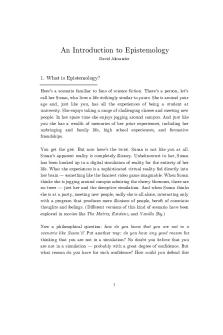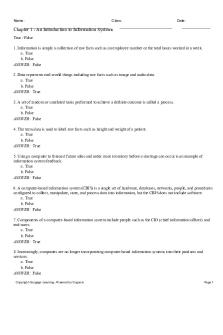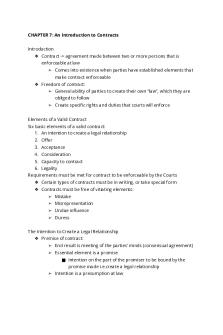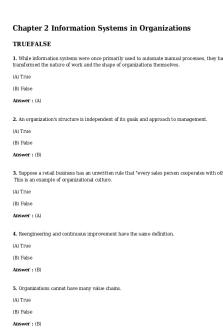Chapter 1 - An Introduction to Chemistry PDF

| Title | Chapter 1 - An Introduction to Chemistry |
|---|---|
| Author | Ali Gee |
| Course | Fundamentals of Chemistry |
| Institution | Southern New Hampshire University |
| Pages | 14 |
| File Size | 142.4 KB |
| File Type | |
| Total Downloads | 23 |
| Total Views | 172 |
Summary
This is the Chapter 1 Notes from the textbook. It is copied from the text without pictures or examples. This is good for Text-To-Speech software that can read you the book aloud....
Description
It is human nature to wonder—about the origins of the universe and of life, about their workings, and even about their meanings. We look for answers in physics, biology, and the other sciences, as well as in philosophy, poetry, and religion. Primo Levi could have searched for understanding in many ways, but his wondering led him to study chemistry...and so has yours, though you may not yet know why.
1.1 What is Chemistry, and What Can Chemistry Do for You? One thing is certain: Once you start studying chemistry, all kinds of new questions will begin to occur to you. Let’s consider a typical day. Your alarm rings early, and you are groggy from sleep but eager to begin working on a chemistry assignment that’s coming due. Chemistry has taught you that there are interesting answers to questions you might once have considered silly and childish. Preparing tea, for example, now makes you wonder why the boiling water bubbles and produces steam while the teakettle retains its original shape. How do the tea leaves change the color of the water while the teabag remains as full and plump as ever? Why does sugar make your tea sweet, and why is the tea itself bitter? You settle down with tea and newspaper, and the wondering continues. An article about methyl bromide, a widely used pesticide, says some scientists think it damages the ozone layer. What are methyl bromide and ozone? How does one destroy the other, and why should we care? How can we know if the ozone really is being depleted? Later, as you drive to the library to get some books you need to complete that chemistry assignment, you wonder why gasoline burns and propels your car down the road. How does it pollute the air we breathe and what does the catalytic converter do to minimize the pollution? At the library, you wonder why some books that are hundreds of years old are still in good shape while other books that are only 50 years old have pages that are brown, brittle, and crumbling. Can the books with damaged pages be saved? Chemists can answer all these questions and others like them. They are scientists who study the structure of material substances—collectively called matter—and the changes that they undergo. Matter can be solid like sugar, liquid like water, or gaseous like the exhaust from your car’s tailpipe. Chemistry is often defined as the study of the structure and behavior of matter. Chemists do a lot more than just answer questions. Industrial chemists are producing new materials to be used to build lighter and stronger airplanes, more environmentally friendly disposable cups, and more efficient anti-pollution devices for your
car. Pharmaceutical chemists are developing new drugs to fight cancer, control allergies, and even grow hair on bald heads. In the past, the chemists’ creations have received mixed reviews. The chlorofluorocarbons (CFCs) used as propellants in aerosol cans are now known to threaten the Earth’s protective ozone layer. The durable plastics that chemists created have proved too durable, so when they are discarded, they remain in the environment for a long, long time. One of the messages you will find in this book is that despite the occasional mistakes and failures, most chemists have a strong social conscience. Not only are they actively developing new chemicals to make our lives easier, safer, and more productive, but they are also working to clean up our environment and minimize the release of chemicals that might be harmful to our surroundings (see Special Topic 1.1: Green Chemistry). As you read on in this book, you will find, perhaps to your disappointment, that only limited portions of each chapter provide direct answers to real-life questions. An introductory chemistry text, such as this one, must focus instead on teaching basic principles and skills. Some of the things you need to learn in order to understand chemistry may seem less than fascinating, and it will not always be easy to see why they are useful. Try to remember that the fundamental concepts and skills will soon lead you to a deeper understanding of the physical world. Before you could run, you needed to learn how to walk. Before you could read a book or write a paper, you needed to learn the alphabet, build your vocabulary, and understand the basic rules of grammar. Chemistry has its own “alphabet” and vocabulary, as well as many standards and conventions, that allow chemists to communicate and to do efficient, safe, and meaningful work. Learning the symbols for the common chemical elements, the rules for describing measurements, or the conventions for describing chemical changes might not be as interesting as finding out how certain chemicals in our brains affect our moods, but they are necessary steps in learning chemistry. This chapter presents some suggestions for making your learning process easier and introduces you to some of the methods of scientific measurement and reporting. You will then be ready for Chapter 2, which gives you a first look at some of chemistry’s underlying concepts. Let’s face it. Chemistry has a reputation for being a difficult subject. One reason is that it includes so many different topics. Individually, they are not too difficult to understand, but collectively, they are a lot to master. Another reason is that these topics must be learned in a cumulative fashion. Topic A
leads to topic B, which is important for understanding topic C, and so on. If you have a bad week and do not study topic B very carefully, topic C will not make much sense to you. Because chemistry is time-consuming and cumulative, you need to be very organized and diligent in studying it. There is no correct way to study chemistry. Your study technique will be decided by your current level of chemical knowledge, the time you have available, your strengths as a student, and your attitude toward the subject. The following is a list of suggestions to help you take chemistry’s special challenges in stride. Use the Review Skills sections in this textbook. Starting with Chapter 2, each chapter begins with a section called Review Skills, complemented at the end of the chapter by a set of review questions that test those skills. The Review Skills section and the review questions identify the specific skills from earlier chapters that are necessary for success in the new chapter. If you have trouble with the tasks on the Review Skills list, you will have trouble with the chapter, so promise yourself that you will always review the topics listed in the Review Skills section before beginning a new chapter. Read each chapter in the textbook before it is covered in lecture. There are several good reasons why a relaxed pre-lecture reading of each chapter is important. It provides you with a skeleton of knowledge that you can flesh out mentally during the lecture, at the same time guaranteeing that there will be fewer new ideas to absorb as you listen to your teacher talk. If you already know a few things, you will be better prepared to participate in class. Attend class meetings, take notes, and participate in class discussions. You will get much more out of a lecture, discussion section, or laboratory—and will enjoy it more—if you are actively involved. Don’t hesitate to ask questions or make comments when the lecture confuses you. If you have read the chapter before coming to class and paid attention to the lecture and you still have a question, you can be fairly certain that other students have that question too and will appreciate your asking for clarification. Reread the chapter, marking important sections and working the practice exercises. In the second reading, mark key segments of the chapter that you think you should reread before the exam. Do not try to do this in the first reading, because you will not know what parts are most important until you have an overview of the material the chapter contains. It is a good idea to stop after reading each section of text and ask yourself, “What have I just read?” This will keep you focused and help you to remember longer. You will find Examples in each chapter that show how to do many of the tasks that you will be asked to do on exams. The examples are
followed by Exercises that you should work to test yourself on these tasks. The answers to these exercises are found at the end of the book. If you have trouble with a practice exercise, look more closely at the example that precedes it, but don’t get bogged down on any one topic. When a new concept or an exercise gives you trouble, apply the 15-minute rule: If you have spent more than 15 minutes on an idea or problem and you still do not understand it, write down what you do not understand and ask your instructor or another student to explain it. Use the chapter objectives as a focus of study. At the end of each chapter is a list of Chapter Objectives that provides a specific description of what you should be able to do after studying the chapter. Notations in the text margins show you where to find the information needed to meet each objective. Your instructor may wish to add to the list or remove objectives from it. Many of the objectives begin with, “Explain...” or “Describe...”. You might be tested on these objectives in short essay form, so it is a good idea to actually write your responses down. This will force you to organize your thoughts and develop a concise explanation that will not take too much time to write on the exam. If you do it conscientiously, perhaps using color to highlight key phrases, you will be able to visualize your study sheet while taking the exam. 1.3 The Scientific Method
Many of the objectives refer to stepwise procedures. This book will suggest one procedure, and sometimes your instructor will suggest another. Write out the steps that you think will work best for you. The act of writing will help you remember longer, and you will find it much easier to picture a study sheet written out in your own handwriting than one printed in this book. Use the computer-based tools that accompany the course. This textbook is accompanied by an Internet site that supplements the text. If you have access to it, you will find it useful at this stage in your studying. Work some of the problems at the end of the chapter. Do not try the end-of-chapter problems too soon. They are best used as a test of what you have and have not mastered in the chapter after all the previous steps have been completed. Note that many of the problems are accompanied by the number of the learning objective to which they correspond. (In fact, the problems serve as examples of ways in which you might be tested on various chapter objectives.) Use the same 15-minute rule for the problems as for the chapter concepts and exercises: If you have spent more than 15 minutes on any one problem, it is
time to seek help. Ask for help when you need it. Don’t be shy. Sometimes five minutes in the instructor’s office can save you an hour or more of searching for answers by other means. You might also consider starting a study group with fellow students. It can benefit those of you who are able to give help as well as those who need it. There is no better way to organize one’s thoughts than to try to communicate them to someone else. There may be other ways to get help. Ask your instructor what is available. Review for the exam. Read the list of objectives, asking yourself whether you can meet each one. Every time the answer is “No,” spend some time making it “Yes.” This might mean meeting with your instructor or study group, rereading this text, or reviewing your notes. Ask your instructor which objectives are being emphasized on the exam and how you are going to be tested on them. Your lecture notes can also provide clues to this. Lastly, work some more of the end-of-chapter problems. This will sharpen your skills and improve your speed on the exam.
1.3 The Scientific Method Before beginning our quest for an understanding of chemistry, let’s look at how science in general is done. There is no one correct way to do science. Different scientific disciplines have developed different procedures, and different scientists approach their pursuit of knowledge in different ways. Nevertheless, most scientific work has certain characteristics in common. We can see them in the story of how scientists discovered the first treatment for Parkinson’s disease, a neurological condition that progressively affects muscle control. The principal steps in the process are summarized in Figure 1.1. Like most scientific work, the development of a treatment for Parkinson’s disease began with observation and the collection of data. In the 1960’s, scientists observed that South American manganese miners were developing symptoms similar to the muscle tremors and rigidity seen in Parkinson’s disease. Next, the scientists made an initial hypothesis on the basis of their observations. Perhaps the symptoms of the manganese miners and of Parkinson’s sufferers had a common cause. The initial hypothesis led to a more purposeful collection of information in the form of systematic research or experimentation. Systematic study of the manganese miners’ brain chemistry showed that manganese interferes with the work of a brain chemical called dopamine. Because dopamine is important in the brain’s control of muscle function, anyone absorbing abnormally high levels of
manganese would be expected to have troubles with movement. The hypothesis was refined based on the new information, and research was designed to test the hypothesis. Specifically, the researchers hypothesized that the brains of Parkinson’s sufferers had low levels of dopamine. Brain studies showed this to be the case. The results were published so that other scientists might repeat the research and confirm or refute the conclusions. Because other scientists confirmed the results of the dopamine research, the hypothesis became accepted in the scientific community. The discovery of the dopamine connection started a search for a drug that would elevate the levels of dopamine in the brain. This provides an example of what is very often the next step of the scientific method, a search for useful applications of the new ideas. Dopamine itself could not be used as a drug because it is unable to pass from the blood stream into the brain tissue. Instead, the researchers looked for a compound that could penetrate into the brain and then be converted into dopamine. Levodopa, or L-dopa, met these requirements. (It should be noted that significant scientific research does not always lead directly to applications, or even to a published paper. One of the main driving forces of science is just the desire to understand more about ourselves and the world around us. Any research that increases this understanding is important.) The development of applications often leads to another round of hypothesizing and testing in order to refine the applications. There was some initial success with L-dopa. It caused remission of Parkinson’s disease in about one-third of the patients treated and improvements in one-third of the others, but there were also problematic side effects, including nausea, gastrointestinal distress, reduced blood pressure, delusions, and mental disturbance. The drug’s effects on blood pressure seem to be caused by the conversion of L-dopa to dopamine outside the brain. For this reason, L-dopa is now given with levocarbidopa, which inhibits that process. And the cycle of hypothesis, experimentation, and finding new applications, which leads to further refinement of the hypotheses continues... 1.4
Measurement and Units
The practice of chemistry demands both accuracy and clarity. The properties of matter must be measured correctly and reported without ambiguity. For example, a chemist has a lot of measuring to do while testing to see whether the pesticide methyl bromide might be destroying the protective layer of ozone gas in the earth’s upper atmosphere. (The ozone in the upper
atmosphere filters out harmful radiation from the sun.) She or he might add a carefully measured amount of methyl bromide to a reaction vessel that already contains ozone and perhaps other chemicals found in our atmosphere. In such an experiment, the temperature, too, would be carefully measured and adjusted to duplicate the average temperature in the ozone layer, and then the substances in the vessel might be subjected to the same measured amounts and kinds of radiation to which ozone is exposed in the atmosphere. Chemical changes would take place, after which the amounts of various substances found in the resultant mixture would be measured and reported at various times. All of these measurements of amounts, temperatures, and times must be carefully reported in a way that enables other scientists to judge the value of the experiment. A measurement is always reported as a value, a quantitative description that includes both a number and a unit. For example, before a 100-meter race is run, the distance must be measured as precisely as possible. Its value is 100 meters. In this value, the unit is meters (defined below), and the number of units is 100. Units are quantities defined by standards that people have agreed to use to compare one event or object to another. For example, at one time the units for length were based on parts of the body. An inch (the unit) was the width of the thumb (the standard), and a foot was the length of a typical adult foot. Centuries ago, you might have described the length of a cart you wanted made as eight feet, meaning eight times the length of your foot. Although the length of a foot varies for different people, this description would be accurate enough to allow the carpenter to make a cart that would fit your purpose. As measuring techniques became more precise and the demand for accuracy increased, the standards on which people based their units were improved. In the 18th century, the French invented the metric system, based on a more consistent, systematic, and carefully defined set of standards than had ever been used before. For example, the meter (or metre, from the Greek metron, “a measure”) became the standard for length. The first definition for the standard meter was one ten-millionth of the distance from the North Pole to the Equator. This became outdated as the precision of scientist’s measuring instruments improved. Today, a meter is defined as the distance light travels in a vacuum in 1/299,792,458 second. Technical instruments for measuring length are calibrated in accordance with this very accurate definition.
The International System of Measurement
The International System of Measurement (SI for Système International d’Unitès), a modern elaboration of the original metric system, was set up in 1960. It was developed to provide a very organized, precise, and practical system of measurement that everyone in the world could use. The SI system is constructed using seven base units, from which all other units are derived (Table 1.1). The chemist is not usually interested in electric currents or luminous intensity, so only the first five of the base units on Table 1.1 will appear in this text. The meaning of mole, the base unit for amount of substance, is explained in Chapter 9. Until then, we will use the first four base units: meter (m), kilogram (kg), second (s), and kelvin (K).
SI Units Derived from Base Units Many properties cannot be described directly with one of the seven SI base units. For example, chemists often need to measure volume (the amount of space that something occupies), and volume is not on the list of SI base units (Table 1.1). Rather than create a new definition for volume, we derive its units from the base unit for length, the meter. Volume can be defined as length cubed, so cubic meters, m3, can be used as a volume unit. Various other units are derived in similar ways. If you have long arms, a meter is approximately the distance from the tip of your nose to the end of your fingers when you are looking forward and extending your arm fully. A cubic meter is therefore a fairly large volume. In fact, it’s inconveniently large for many uses. You’d find it awkward to buy your milk by a small fraction of a cubic meter, such as 1/1000 m...
Similar Free PDFs

1. An Introduction to Epistemology
- 10 Pages

1. An Introduction to Glaciers
- 6 Pages

An introduction to Psychology
- 4 Pages

An introduction to sociolinguistics
- 451 Pages
Popular Institutions
- Tinajero National High School - Annex
- Politeknik Caltex Riau
- Yokohama City University
- SGT University
- University of Al-Qadisiyah
- Divine Word College of Vigan
- Techniek College Rotterdam
- Universidade de Santiago
- Universiti Teknologi MARA Cawangan Johor Kampus Pasir Gudang
- Poltekkes Kemenkes Yogyakarta
- Baguio City National High School
- Colegio san marcos
- preparatoria uno
- Centro de Bachillerato Tecnológico Industrial y de Servicios No. 107
- Dalian Maritime University
- Quang Trung Secondary School
- Colegio Tecnológico en Informática
- Corporación Regional de Educación Superior
- Grupo CEDVA
- Dar Al Uloom University
- Centro de Estudios Preuniversitarios de la Universidad Nacional de Ingeniería
- 上智大学
- Aakash International School, Nuna Majara
- San Felipe Neri Catholic School
- Kang Chiao International School - New Taipei City
- Misamis Occidental National High School
- Institución Educativa Escuela Normal Juan Ladrilleros
- Kolehiyo ng Pantukan
- Batanes State College
- Instituto Continental
- Sekolah Menengah Kejuruan Kesehatan Kaltara (Tarakan)
- Colegio de La Inmaculada Concepcion - Cebu











